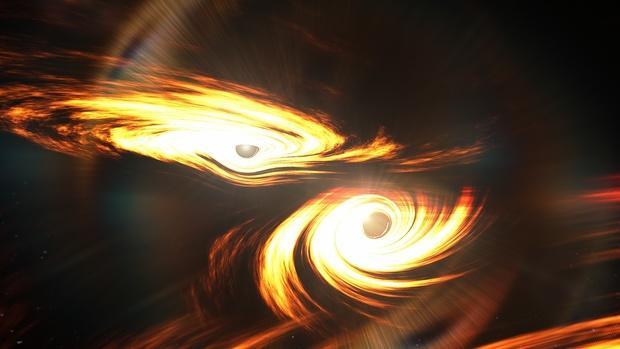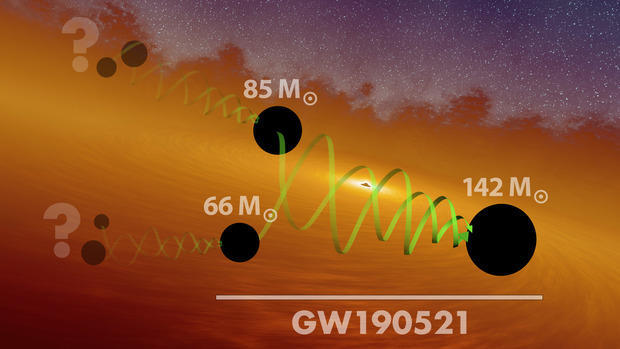Astronomers detect super-rare type of black hole for the first time
Scientists have detected what they believe to be the most powerful, most massive, most distant merger of two black holes in the history of the universe, releasing the energy of eight suns. And from that event, they've detected something even more special — a super-rare type of black hole.
The result of the collision is an "intermediate-mass" black hole, with a mass between 100 and 1,000 times that of the sun. It's the first one that has ever been found, scientists said.
Some black holes, referred to as "stellar" are relatively small, up to 10 times the mass of the sun, forming when a star explodes and dies. Other black holes, called "supermassive," are unfathomably large, amounting to billions of times the mass of the sun, such as Sagittarius A*, at the center of the Milky Way.
This new black hole's "medium" size — not too big, not too small — makes it an anomaly.
Scientists believe two black holes, with masses about 85 and 66 times the mass of the sun, collided to produce a signal, in the most massive merger ever detected. The signal, called GW190521, appears to represent the exact moment the two black holes crashed into each other.
Researchers say the event created an even more massive black hole, about 142 times the mass of the sun. It also released a huge "bang" of leftover energy, equivalent to about eight solar masses, in the form of gravitational waves able to be detected on Earth.
An international team of scientists detected GW190521 on May 21, 2019, using the National Science Foundation's Laser Interferometer Gravitational-wave Observatory (LIGO) interferometers in the U.S. and the Virgo detector in Italy. They published their findings in two papers Tuesday, Physical Review Letters and The Astrophysical Letters Journal.
"This doesn't look much like a chirp, which is what we typically detect," Virgo researcher Nelson Christensen, from the French National Centre for Scientific Research (CNRS), said in a press release. "This is more like something that goes 'bang,' and it's the most massive signal LIGO and Virgo have seen."
In black holes, gravity is so strong that no light can escape — making them completely invisible. So, the gravitational waves they release are crucial to researching these types of events.
GW190521 is an extremely quick signal, lasting less than one-tenth of a second. It appears to be generated by a source dating back to when the universe was about half its age — some 7 billion years ago — making it one of the most distant gravitational wave sources ever detected.
But the detection of GW190521 seems to have left more questions than answers.
Not only is the resulting black hole from the collision the first of its kind to be detected, but scientists also suspect that the black holes that produced it are unique in their size. Most stellar-mass black holes form from collapsing stars, but in this case, the weight of one of the black holes means it should not have been able to be involved in such an event — leading scientists to question how it came into existence.
"The fact that we're seeing a black hole in this mass gap will make a lot of astrophysicists scratch their heads and try to figure out how these black holes were made," Christensen said.
Scientists hypothesize the two original black holes formed from an even smaller black hole merger. In that case, four black holes danced around each other until they became two, and eventually one.
"This event opens more questions than it provides answers," said LIGO researcher Alan Weinstein, a physics professor at Caltech. "From the perspective of discovery and physics, it's a very exciting thing."
Scientists believe the gravitational waves were born from a binary merger. But they also entertain alternative possibilities — maybe the waves were emitted by a collapsing star or a cosmic string just after the universe was created.
"Since we first turned on LIGO, everything we've observed with confidence has been a collision of black holes or neutron stars," Weinstein said. "This is the one event where our analysis allows the possibility that this event is not such a collision."
"Although this event is consistent with being from an exceptionally massive binary black hole merger, and alternative explanations are disfavored, it is pushing the boundaries of our confidence," Weinstein added. "And that potentially makes it extremely exciting. Because we have all been hoping for something new, something unexpected, that could challenge what we've learned already. This event has the potential for doing that."






